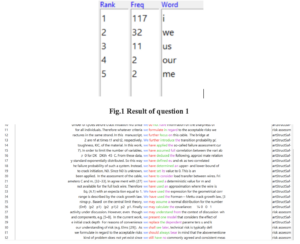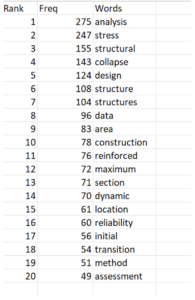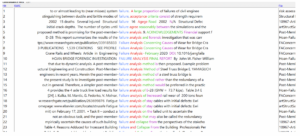Introduction: Have you ever wondered how Engineers write papers, especially Civil Engineering? The purpose of this project is to analyze texts in Civil engineering and find out the writing style of engineers and how they structure academic writings. As a Civil Engineer, I haven’t got the chance to write an essay for my major since what we mostly do is calculations and exams. I would like to observe their writing style and what words they mostly use. This will help me get a sense of engineers’ writings. I will also build my writing skills through observing 8 different texts that relate to Civil Engineering and use them as a guide in the future. There are four questions I came up with to help me get a result from this project. There are two main topics that I’m focusing on and they are a really big deal in the engineering industry; Bridge failure and Building collapse.
The questions I’m focusing on are Are first person pronouns used in these academic articles? What are the first 20 Academic words that are mostly used in this field? How many images are in each article? How many times do keywords like structure, building, collapse, design, engineering and so on come up in these texts? I expect to see words like collapse, structure, stress and bridge used mostly. I also expect to see many figures in these articles including pictures and tables since engineers tend to include pictures of the project they are analyzing and tables that have a lot of data on it. I’m also expecting to find academic words like “failure”, “structure”, “collapse”and “bridge” in articles. I don’t think they will use first-person pronouns since Engineering articles are mostly written in third person.
Method: I chose eight different articles from google scholar and they are all related to my major; Civil Engineering. The first four articles are about investigating and analyzing bridge failures. When I was choosing the articles, I wrote analyzing bridge failure on the search button. This allowed me to get access to so many different articles that were written in different years. The method I used to choose these specific articles was to find if I can get access to their PDF file first without going through the Lafayette Library. I knew that with the short amount of time I had, I couldn’t get access to some of the first articles that came out first. I decided to skip the ones that I can’t get access to and move on to the top four articles that come up first where their PDF is available. The other four articles are about building failure which is also common in the Civil engineering field. This time, I chose them based on the number of citations. If It has a lot of citations and it came up first, I chose it. For these articles, I also used the PDF method. If the ones that came up first had a PDF file and the number of citations was high, I added them to my list. This way, I’m able to observe articles that are mostly used in engineering. Having two different topics will allow me to see different perspectives of failure projects. My corpus had 5614 word time and 62814 word tokens.
The tools I will be using for this project are the AntCon, google scholar,note text and the academic word list. Note text will allow me to keep everything in txt since that’s what AntConc will read. I used the word list to identify the most academic words that are used. The Concordance plot in Antconc helped me identify where on the texts where first-person pronouns were used. I also used txt to put (I, we, me, us, my, mine, our, ours) and then I used tool preferences where I clicked “word list” then “use Specific words below to upload my Txt file that had the first-person pronouns and I got the list I was looking for. My inclusion criteria are the articles should talk about some sort of failure whether it is a bridge or a building. My exclusion criteria are these articles can be from anywhere in the world. I was not focusing on one location since that will limit my access.
Below are the eight different articles that I will be analyzing :
- Fatigue failure analysis of stay cables with initial defects: Ewijk bridge case study
- Hoan Bridge Forensic Investigation failure analysis final report.
- Post-Member-Failure Analysis Method of Steel Truss Bridge
- Failure Analysis Concerning Causes of Wear for Bridge Crane Rails and Wheels
- An Empirical Ascertainment of the Causes of Building Failure and Collapse in Nigeria
- Field investigation on the performance of building structures during the 12 May 2008 Wenchuan earthquake in China
- Risk assessment for civil engineering facilities: critical overview and discussion
- Progressive Collapse Analysis of An RC Structure
Findings and Discussion: When I observed if these articles used first-person pronouns, I got a result that I was not expecting. The table below shows that “I” was used 117 times and that”we” was used 32 times. Since these are academic articles and they are about incidents that occured, I found it weird to see that number of “I”. Later when I clicked on “I”, I found out that the way I was used was different from what I was trying to observe. The way “I” is used is shown in figure 3 where you can see examples of I. For example, “i.e” is one way that I was counted. Figure 1 is an example of what antcont counted instead of what I expected. On the other hand, there were 32 times that “we” was used and I observed that a noun comes most of the time “we” is used. Figure two shows how “we” was used.

One thing I noticed as I was looking through the articles was that engineers use a lot of pictures and tables in their academic writings. It’s hard to describe when analyzing a failure. They will draw how it used to look like on autocad and use that drawing to describe what they want to explain. They also take pictures of where the failure happens on bridges and buildings and include that in their articles. One of the questions I wanted to search was to see how many figures and images each article has. This was something hard to do at AntCon. I went through each and every article and counted how many figures and images there were. The result I got from it was similar to what I expected. You can see it below what I found.I was only counting the pictures. For example, the Risk assessment article did not have pictures but there were 6 graphs and tables in there. The same goes for article 5 where 2 to 3 pages of the article were full of tables which had data. I was only focusing on images and drawings. On the other hand, there were articles that had images on almost every page because of how detailed they wanted to be. Figure 2 shows the result of what I got from the 8 articles. 
The third part of my research was focusing on the mostly common academic words used. To find this out, I used an AWL.txt file that contains all of the academic words. The result I got is shown in Figure 3. I found out that “Analysis” is the most common academic word used and it appeared 275 times. Most of these words can be a noun or a verb depending on how they are used. For example, stress is the second most common word and it’s used as a noun in these articles. 
“Structure” was one of the words I wanted to see how many times it was used and it made it to the 20 most common words that were used. It was used 108 times and I expect that because the articles I’m analyzing have something to do with structure whether it’s a building or a bridge. Collapse was also one of the words that were used a lot and it was used 143 times. Even though the word failure is not part of the academic word list, it was used 231 times and most of the time “analysis” comes after its use. Figure 6 shows an example of failure.

Conclusion: After I used AntConc and the academic world list that my professor provided us; I was able to get a result that satisfied my expectations. For example, one of the questions I wanted to observe was the academic words that were mostly used. Out of the 20 words I analyzed, 15 of them are words that my strength of Material class uses a lot. I get a sense of how accurate the list of academic words is and the fact that most of these words are what my engineering classes use a lot. As I was doing this analysis, I realized the role pictures play in the engineering industry and what they represent. Most of these articles had images that were referring to what the article was about and it is easy to follow the flow of the article with these images. Antconc also helped to identify if first-person pronouns are used in academic papers and I found out that a little bit is used. This research helped me figure out the writing style of Civil Engineers. In my senior thesis, I will be able to write a paper with the help of this project. Next time I do research like this, I will try to be consistent with the way I find articles.
Bibliography
Ayedun, C. A., O. D. Durodola, and O. A. Akinjare. “An empirical ascertainment of the causes of building failure and collapse in Nigeria.” Mediterranean Journal of Social Sciences 3.1 (2012): 313-313.
Faber, Michael H., and Mark G. Stewart. “Risk assessment for civil engineering facilities: critical overview and discussion.” Reliability engineering & system safety 80.2 (2003): 173-184.
Fisher, John W., et al. Hoan bridge forensic investigation failure analysis final report. No. Final Report. Wisconsin Department of Transportation, 2001.
Kulka, Jozef, et al. “Failure analysis concerning causes of wear for bridge crane rails and wheels.” Engineering Failure Analysis 110 (2020): 104441.
Maljaars, Johan, and Ton Vrouwenvelder. “Fatigue failure analysis of stay cables with initial defects: Ewijk bridge case study.” Structural Safety 51 (2014): 47-56.
Sasani, Mehrdad, and Jesse Kropelnicki. “Progressive collapse analysis of an RC structure.” The Structural Design of Tall and Special Buildings 17.4 (2008): 757-771.
Yamaguchi, E., R. Okamoto, and K. Yamada. “Post-member-failure analysis method of steel truss bridge.” Procedia engineering 14 (2011): 656-661.
Zhao, Bin, Fabio Taucer, and Tiziana Rossetto. “Field investigation on the performance of building structures during the 12 May 2008 Wenchuan earthquake in China.” Engineering Structures 31.8 (2009): 1707-1723.
